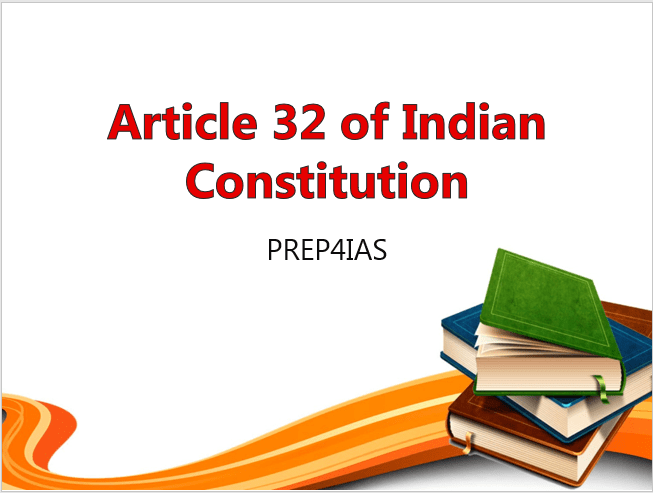In this Session, we will discuss Important Questions on Article 32 of Indian Constitution and Its Similarity with Article 226. As you might know Fundamental Rights are mentioned in Indian Constitution from Article 12 to Article 36 to provide basic rights to Citizen of India. In this session, we will try to understand what one can do when your fundamental rights get violated and which all articles can be used in those cases.
This is very important topic from the perspective of UPSC Exam Syllabus and lot of questions get asked from this topic so we will try to see all the important questions that can be asked from Article 32 of Indian Constitution and Its similarity with Article 226.

Article 32 of Indian Constitution
Also Read: 30 Useful Questions on 74th and 75th Amendment of Indian Constitution
1. What can one do when his/her fundamental right is getting violated ?
Ans. He/She can use Article 32 of Indian Constitution and can directly reach out to Supreme Court or he/she can use Article 226 and reach out to High Court.
2. What kind of power Article 32 of Indian Constitution provides to Supreme Court ?
Ans. Using Article 32 of Indian Constitution, Supreme Court can issue five different types of writs to protect one's fundamental rights.
3. Which article makes Supreme Court "protector and guarantor" of Fundamental Rights ?
Ans. Article 32 of Indian Constitution
4. Which Article was called as the "Heart and Soul" of Indian Constitution by Dr.B.R Ambedkar ?
Ans. Article 32 of Indian Constitution
5. Apart from Article 32 which other article has the power to issue writs to protect one's fundamental right ?
Ans. Article 226 has the same power as Article 32 to issue writs by the High Court.
6. Is it necessary to go to High Court before Supreme Court to protect your fundamental rights ?
Ans. No. But you might have to explain to Supreme Court why High Court is not been approached first.
7. What is the difference between Article 32 and 226 ?
Ans. There are two main difference between Article 32 and 226:-
a) Under Article 32 of Indian Constitution, writs can only be issued to protect fundamental rights.On the other hand, under Article 226, writs can be issued to protect fundamental rights as well as for some other purposes like writ against the decision of an Administrative Tribunal.
b) Since Article 32 of Indian Constitution comes under Part III of the constitution so this constitutional remedy comes under Fundamental Right whereas Article 226 is not a Fundamental Right. More on Constitution of India
8. How many types of writs are there ?
Ans. There are 5 types of writs:-
a) Habeas Corpus
b) Mandamus
c) Certiorari
d) Prohibition
e) Quo Warranto
9. What is writ ?
Ans. It is a kind of constitutional remedy.
10. In which four conditions writ of Habeas Corpus cannot be used ?
Ans. Those four conditions are:-
a) When detention is Lawful.
b) In Contempt of Court.
c) When detention is outside the Jurisdiction of the court.
d) When detention is by a competent court.
11. When can one use the writ of Habeas Corpus ?
Ans. When a person is illegally detained.
12. Can you explain Habeas Corpus through the Case of Rudul Shah vs State of Bihar ?
Ans. In this case, one person Rudul Shah who had already completed his confinement period was in prison for extra 14 years. So Habeas Corpus was used to release him immediately from the Prison Confinement and also ordered to pay the exemplary damages.
13. Where can one use the writ of Mandamus ?
Ans. When you have to command someone(statutory/non-statutory) to perform his public duty.
14. Can you explain Mandamus through the Case of Gujarat State Financial Corporation vs Lotus Hotels ?
Ans. In this case, Gujarat State Financial Corporation had an agreement with Lotus Hotels to release funds for Construction Work. But later on GSFC refused to release the fund as a result Lotus Hotels reached out to Gujarat High Court. Then Gujarat High Court issue mandamus to GSFC to perform his public duty.
15. What is the condition to apply Mandamus writ?
Ans. It requires to have a public duty.
16. When can a Judgement of Lower Courts becomes Illegal ?
Ans. It can become illegal due to below factors:-
a) When there is an Excess of Jurisdiction
b) When there is a Lack of Jurisdiction
c) When Jurisdiction is Unconstitutional
d) When Principles of Nature Justice Violated
17. What is the meaning of Quo Warranto ?
Ans. It means "By what authority".
18. Where can you use the writ of "Quo Warranto" ?
Ans. When you have to ask someone by which authority public office has been assumed.
19. Where can you use the writ of Prohibition ?
Ans. When you want to stop a court to pronounce his Judgement.
20. What if a Judgement is already pronounced and you want to stop that judgement to come into effect ?
Ans. In that case you can use writ of Certiorari.
21. What does writ of Certiorari is being used ?
Ans. When some judgement is already pronounced and it found to be an Illegal one then you can use writ of Certiorari to quashed that Judgement.
22. What is the main difference between writ of Prohibition and writ of Certiorari ?
Ans. When Judgement is not pronounced then you can use writ of Prohibition but if Judgement is pronounced then you have to use writ of Certiorari to quashed that Judgement.
23. Which are two famous cases for which writ of Certiorari has been issued ?
Ans. Two of the famous cases are:-
a) Gullapalli NageshwarRao vs APSRTC
b) A.K Kripak vs Union of India
